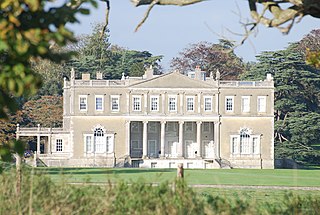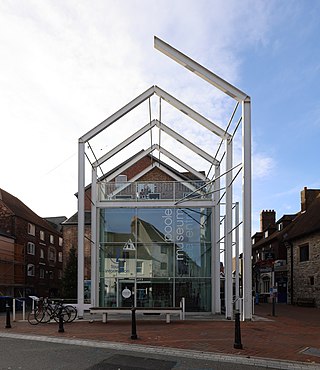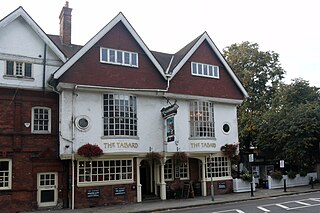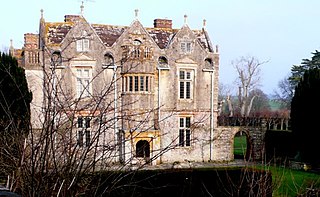
Kingston Lacy is a country house and estate near Wimborne Minster, Dorset, England. It was for many years the family seat of the Bankes family who lived nearby at Corfe Castle until its destruction in the English Civil War after its incumbent owners, Sir John Bankes and Dame Mary, had remained loyal to Charles I.

Edmondsham is a village in Dorset, England. It is 2 miles (3 km) north west of Verwood and 10 miles (16 km) north of Bournemouth, near the source of a small stream which flows into the River Crane, Dorset; both are Sites of Special Scientific Interest. In the 2001 census it had a population of 200.

Wootton Fitzpaine is a village and civil parish in the county of Dorset in South West England. It lies approximately 3 miles (4.8 km) north-east of Lyme Regis in a small side valley of the River Char, close to the Marshwood Vale. The civil parish covers an area of 3,307 acres (1,338 ha) and includes the ecclesiastical parish and small settlement of Monkton Wyld to the west. In the 2011 census the civil parish had 180 dwellings, 134 households and a population of 345.

Sherborne Castle is a 16th-century Tudor mansion southeast of Sherborne in Dorset, England, within the parish of Castleton. Originally built by Sir Walter Raleigh as Sherborne Lodge, and extended in the 1620s, it stands in a 1,200-acre (490 ha) park which formed a small part of the 15,000-acre (61 km2) Digby estate. Within the grounds lie the ruins of the 12th-century Sherborne Old Castle, now in the care of English Heritage.

Kingston Maurward House is a large Grade I listed Georgian English country house set in a 750-acre estate in Dorset situated in the Frome valley two miles east of Dorchester.
Cranborne Hundred was a hundred in the county of Dorset, England, containing the following parishes:
Bindon Liberty was a liberty in the county of Dorset, England, containing the following parishes:

Coade stone or Lithodipyra or Lithodipra is stoneware that was often described as an artificial stone in the late 18th and early 19th centuries. It was used for moulding neoclassical statues, architectural decorations and garden ornaments of the highest quality that remain virtually weatherproof today.

The Barn, in Exmouth, Devon, England, is a seaside house, now a hotel, dating from 1896 and designed in Arts and Crafts style by the architect Edward Schroeder Prior. It is a Grade II* listed building.

Crichel House is a Grade I listed Classical Revival country house near the village of Moor Crichel in Dorset, England. The house has an entrance designed by Thomas Hopper and interiors by James Wyatt. It is surrounded by 400 acres of parkland, which includes a crescent-shaped lake covering 50 acres. The parkland is Grade II listed in the National Register of Historic Parks and Gardens.

Poole Museum is a currently closed local history museum situated on the Lower High Street in the Old Town area of Poole, Dorset, and is part of the Borough of Poole Museum Service. Entrance to Poole Museum is free, and the museum is the fifth most visited free attraction in South West England.

Ven House in Milborne Port, Somerset, England is an English manor house that has been designated as a Grade I listed building.

Cranborne Manor is a Grade I listed country house in Cranborne, Dorset, in southern England.

Nothe Gardens is a public garden, located in Weymouth, Dorset, England. Positioned on the Nothe Peninsula overlooking both Weymouth and Portland harbours, the informal gardens are often acclaimed to be the most beautiful the borough has to offer.

Governor's Community Garden is a public garden, located on the Isle of Portland, Dorset, England. It is found within The Grove village, opposite the site of HM Prison Portland.

The block of three buildings containing The Tabard public house is a Grade II* listed structure in Chiswick, London. The block, with a row of seven gables in its roof, was designed by Norman Shaw in 1880 as part of the community focus of the Bedford Park garden suburb. The block contains the Bedford Park Stores, once a co-operative, and a house for the manager.
Bloxworth House is a Grade I listed manor house just northwest of the village of Bloxworth in Dorset, England. It was built in 1608 by George Savage and was the first brick building in Dorset.

Southill Park contains the site of late medieval Gastlings or Gastlyns Manor House and is the name given to a country house in Southill, Bedfordshire, its adjoining privately owned gardens and separate public parkland; it includes a lake and woodland. Its focal point is an early Georgian house, for disambiguation known as Southill Park House which is a heritage-listed building in the highest category. The parkland has legal designations in heritage and plant or wildlife protection. Further structures in the grounds have heritage protection including the follies of a Tuscan architecture temple and a partially stone-faced bridge, both designed by Henry Holland.

Percy Richard Morley Horder was an English architect who early in his career worked from offices in Stroud and later in London. His early work was in the Arts and Crafts style, but after the First World War his buildings were increasingly in the Neo-Georgian fashion. His work included public houses for the Godsell Brewery and designing new country houses or partially rebuilding existing houses. He also designed country-house gardens and is noted for laying out Highfields Park, Nottingham together with the adjacent Nottingham University Campus. He undertook architectural work in many parts of the British Isles including Ireland. He is probably best remembered for the Trent Building in the University of Nottingham. and for design of the London School of Hygiene and Tropical Medicine. His work at Upton House, Warwickshire for Viscount Bearsted is notable, but it is his work for Jesse Boot, both the Boots the Chemists stores, but most importantly the Trent Building and the laying out the campuses of the University of Nottingham, which influenced design at other English universities, for which he must take the greatest credit.

Waterston Manor, Puddletown, Dorset is a manor house with 17th century origins, that was extensively rebuilt after a fire in 1863 and remodelled in 1911. The manor was the inspiration for Weatherbury Farm in Thomas Hardy's novel, Far from the Madding Crowd. It is a Grade I listed building.





















